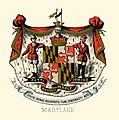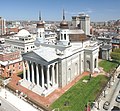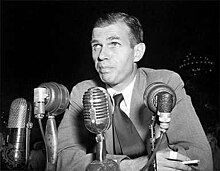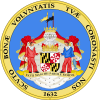Portal:Maryland
|
Maryland Portal
|
Baltimore Task Force
|
Frederick Task Force
|
Montgomery Task Force
|
WikiProject Maryland
|
|
Main page
|
Discussion
|
Introduction Maryland (US: /ˈmɛrɪlənd/ ⓘ MERR-il-ənd) is a state in the Mid-Atlantic region of the United States. The state borders Virginia to its south, West Virginia to its west, Pennsylvania to its north, Delaware to its east, the Atlantic Ocean, and the national capital of Washington, D.C. With a total area of 12,407 square miles (32,130 km2), Maryland is the ninth-smallest state by land area, and its population of 6,177,224 ranks it the 18th-most populous state and the fifth-most densely populated. Maryland's capital is Annapolis, and the most populous city is Baltimore. Occasional nicknames include Old Line State, the Free State, and the Chesapeake Bay State. It is named after Henrietta Maria, the French-born queen of England, Scotland, and Ireland during the 17th century. Maryland's coastline was first explored by Europeans in the 16th century. Prior to that, it was inhabited by several Native American tribes, mostly the Algonquian peoples and, to a lesser degree, Iroquoians and Siouans. As one of the original Thirteen Colonies, Maryland was founded by George Calvert, 1st Baron Baltimore, a Catholic convert who sought to provide a religious haven for Catholics persecuted in England. In 1632, Charles I of England granted Lord Baltimore a colonial charter, naming the colony after his wife, Henrietta Maria. Unlike the Pilgrims and Puritans, Lord Baltimore envisioned a colony where people of different religious sects would coexist under the principle of toleration. In 1649, the Maryland General Assembly passed an Act Concerning Religion, which enshrined this principle by penalizing anyone who "reproached" a fellow Marylander based on religious affiliation. Nevertheless, religious strife was common in the early years, and Catholics remained a minority, albeit in greater numbers than in any other English colony. Maryland's early settlements and population centers clustered around rivers and other waterways that empty into the Chesapeake Bay. Its economy was heavily plantation-based and centered mostly on the cultivation of tobacco. Demand for cheap labor from Maryland colonists led to the importation of numerous indentured servants and enslaved Africans. In 1760, Maryland's current boundaries took form following the settlement of a long-running border dispute with Pennsylvania. Maryland was an active participant in the events leading up to the American Revolution, and by 1776, its delegates signed the Declaration of Independence. Many of its citizens subsequently played key political and military roles in the war. Although then a slave state, Maryland remained in the Union during the American Civil War, its strategic location giving it a significant role in the conflict. After the Civil War, Maryland took part in the Industrial Revolution, driven by its seaports, railroad networks, and mass immigration from Europe. Since the 1940s, the state's population has grown rapidly, to approximately six million residents, and it is among the most densely populated U.S. states. , Maryland had the highest median household income of any state, owing in large part to its proximity to Washington, D.C., and a highly diversified economy spanning manufacturing, retail services, public administration, real estate, higher education, information technology, defense contracting, health care, and biotechnology. Maryland is one of the most multicultural states in the country; it is one of the six states where non-Whites compose a majority of the population, with the fifth-highest percentage of African Americans, and high numbers of residents born in Africa, Asia, Central America, and the Caribbean. The state's central role in U.S. history is reflected by its hosting of some of the highest numbers of historic landmarks per capita. (Full article...) This is a Featured article, which represents some of the best content on English Wikipedia..
 The Baltimore Steam Packet Company, nicknamed the Old Bay Line, was an American steamship line from 1840 to 1962 that provided overnight steamboat service on Chesapeake Bay, primarily between Baltimore, Maryland, and Norfolk, Virginia. Called a "packet" for the mail packets carried on government mail contracts, the term in the 19th century came to mean a steamer line operating on a regular, fixed daily schedule between two or more cities. When it closed in 1962 after 122 years of existence, it was the last surviving overnight steamship passenger service in the United States. In addition to regularly calling on Baltimore and Norfolk, the Baltimore Steam Packet Company at various times provided freight, passenger and vehicle transport to Washington, D.C., Old Point Comfort, and Richmond, Virginia. The Old Bay Line, as it came to be known by the 1860s, was acclaimed for its genteel service and fine dining, serving Chesapeake Bay specialties. Walter Lord, famed author of A Night to Remember (and whose grandfather had been the packet line's president from 1893 to 1899), mused that its reputation for excellent service was attributable to "some magical blending of the best in the North and the South, made possible by the Company's unique role in 'bridging' the two sections ... the North contributed its tradition of mechanical proficiency, making the ships so reliable; while the South contributed its gracious ease". (Full article...)General imagesIn the news
On this day...This is a Good article, an article that meets a core set of high editorial standards.
Same-sex marriage has been legally recognized in Maryland since January 1, 2013. In 2012, the state's Democratic representatives, led by Governor Martin O'Malley, began a campaign for its legalization. After much debate, a law permitting same-sex marriage was passed by the General Assembly (Maryland's bicameral legislature, composed of the Senate and the House of Delegates) in February 2012 and signed on March 1, 2012. The law took effect on January 1, 2013 after 52.4% of voters approved a statewide referendum held on November 6, 2012. The vote was hailed as a watershed moment by gay rights activists and marked the first time marriage rights in the United States had been extended to same-sex couples by popular vote.
Selected article -Alger Hiss (November 11, 1904 – November 15, 1996) was an American government official accused in 1948 of having spied for the Soviet Union in the 1930s. The statute of limitations had expired for espionage, but he was convicted of perjury in connection with this charge in 1950. Before the trial Hiss was involved in the establishment of the United Nations, both as a US State Department official and as a UN official. In later life, he worked as a lecturer and author. On August 3, 1948, Whittaker Chambers, a former US Communist Party member, testified under subpoena before the House Un-American Activities Committee (HUAC) that Hiss had secretly been a communist while in federal service. Hiss categorically denied the charge and subsequently sued Chambers for libel. During the pretrial discovery process of the libel case, Chambers produced new evidence allegedly indicating that he and Hiss had been involved in espionage. A federal grand jury indicted Hiss on two counts of perjury. After a mistrial due to a hung jury, Hiss was tried a second time, and in January 1950 he was found guilty and received two concurrent five-year sentences, of which he eventually served three and a half years. (Full article...)Did you know?

SubcategoriesSelect [+] to view subcategories
TopicsRelated portalsAssociated WikimediaThe following Wikimedia Foundation sister projects provide more on this subject:
Discover Wikipedia using portals |























































